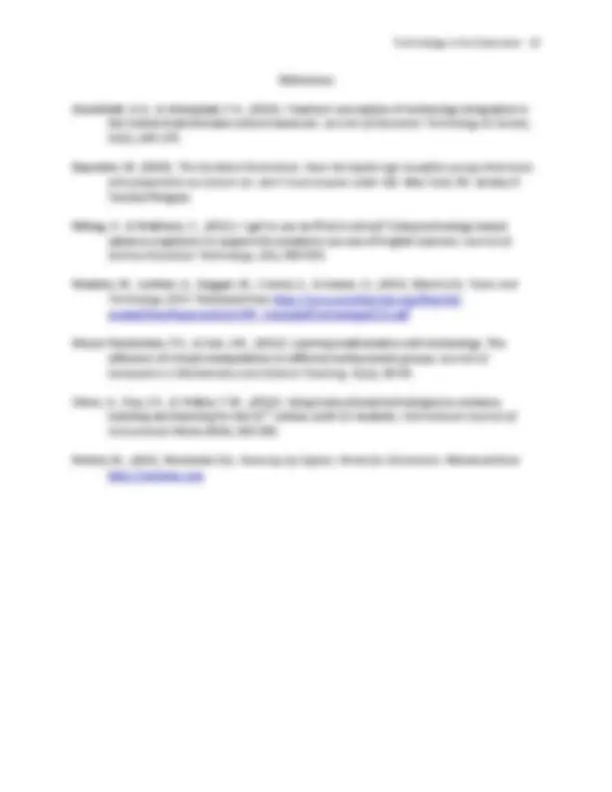









Study with the several resources on Docsity

Earn points by helping other students or get them with a premium plan


Prepare for your exams
Study with the several resources on Docsity

Earn points to download
Earn points by helping other students or get them with a premium plan
Community
Ask the community for help and clear up your study doubts
Discover the best universities in your country according to Docsity users
Free resources
Download our free guides on studying techniques, anxiety management strategies, and thesis advice from Docsity tutors
Technology evolution is based on its application in every field of life. Education without technology has gone obsolete specially after covid-19
Typology: Essays (university)
1 / 13

This page cannot be seen from the preview
Don't miss anything!








Integrating Technology into the Classroom Trevor Moore Western Oregon University
Introduction: In our ever-‐evolving world, we have seen the emergence of technology in all aspects of our lives. People use technology as a form of entertainment, as a tool to help them communicate with other people, to help them monitor their health and as a tool to help them enhance their work. When out in public, it is common to see numerous people using some form of technologic device. While at the mall, it is common to see people talking on their phones, texting people or posting on their social network sites. At a doctor’s offices you will likely see people playing on their tablets or using their cell phones, and it is even common practice to see these devices being used by people who are working out at the gym. Although technology has been embraced in many areas of society, there are still some areas that resist it. Oliver, Osa & Walker explain that “While society in general has embraced 21 st century technology innovations for daily living, a gap remains in the understanding of appropriate uses for technology in the learning environment (Banister & Ross, 2006)” (2012). Unfortunately instructional technologies have not been utilized to their full potential. The focus of this essay is to show that instructional technologies should be integrated into the classroom because when they are used appropriately, they can have a positive impact on student achievement. Throughout this essay the ideas of leading advocates of integrating technology into the classroom will be discussed. These leading advocates are: Billings & Mathison, 2011; Moyer-‐Packenham & Suh, 2012; Madden, Lenhart, Duggan, Cortesi & Gasser, 2013; Bauerlein, 2008. The ideas of leading critics of integrating technology into the classroom will be addressed. The critics addressed in this essay are: Richtel, 2010; Almekhlafi & Almeqdadi, 2010.
that are inappropriate during class time. Critics also believe that not only are the technologies distracting students, they also disrupt the lessons flow. Technological devices take time to be turned on, warmed up and set to the correct application that is needed for a specific lesson or activity. Another problem that critics have with implementing instructional technologies into the classroom is that they are very unreliable. Many times there are technical issues that cause the devices to either work very slowly or often times not even work at all. Some educators believe that these issues make it not worth the time and effort to try and implement these devices into their teaching practices (Richtel, 2010; Almekhlafi & Almeqdadi, 2010). Advocates of Integrating Technology into the Classroom: Advocates’ main argument of implementing instructional technologies into the classroom is that when they are used in appropriately they increase student achievement. Billings and Mathison (2011) discuss two ways that instructional technologies aide in raising student achievement is that they do a very good job of engaging the students in the material, and they get students excited to participate in educational activities. For this study, Billings & Mathison (2011) had a group of fourth grade students participate in a camp in which they would go to a local museum and participate in a variety of activities that were connected to the California state standards. The students first took a pre-‐test about the information that they would learn, and then they were split into two groups. Group one got to watch podcasts on their own iPod before and after the activities each day, which highlighted the important information. The students that were in group one were allowed to watch the podcasts as many times as they wanted to so that they completely understood the material. The students in group two watched the same videos one time before they participated in the day’s activities
and one time after they completed the day’s activities. These students also had to watch the videos on a DVD with the rest of the group rather than by themselves on their own iPod. Throughout the study, Billings and Mathison (2011) noticed that the students in the first group seemed to be much more excited to participate in the activities that the students in the second group. One of the museum educators stated that “…students receiving the podcast intervention demonstrated high levels of knowledge retention and increased excitement about learning the material” (Billings & Mathison, 2011). After completing all of the activities the students took a post-‐test over the information that they learned. Billings and Mathison (2011) found that the students in group one achieved much larger learning gains than the students in group two achieved. This study shows that Billings and Mathison (2011) were able to effectively integrate the use of iPods into their activities and that the iPods increased student achievement and student engagement. Another reason why some educators are advocating for the integration of instructional technologies into the classroom is because they can be tailored to reach every student’s learning needs regardless of their achievement level. Moyer-‐Packenham and Suh (2012) demonstrated how teachers can implement the use of a piece of technology into a single lesson, an activity or an entire unit that will allow all of their students to have success no matter what their achievement level is. Moyer-‐Packenham and Suh (2012) wanted to see if integrating virtual manipulatives into mathematics lessons would have an influence on different achievement groups. Moyer-‐Packenham and Suh (2012) split the 58 fifth grade students into four groups. There was one low achievement group, two average achievement groups and one high achievement group. The low achievement group, one of the average achievement groups
technology. In the United States 93 percent of children between the ages of 12 and 17 have a computer at their home and 23 percent of students today that are between 12 years old and 17 years old have a tablet computer (Madden, Lenhart, Duggan, Cortesi & Gasser, 2013, 1). This means it is likely that if you have 30 students in your class, 21 of them have a computer at home and 18 of them have a tablet computer. If students are becoming familiar with using various devices, teachers need to try and utilize these skills to help them better teach their students. These are two reasons that some educators believe that if we truly want to connect the students to the material and get them excited about learning, we have to implement technology into our classrooms. In The Dumbest Generation: How the digital age stupefies young Americans and jeopardizes our future (or, don’t trust anyone under 30), Bauerlein recalled a time when he was teaching in which he gave his students a homework assignment in which they needed to memorize a poem of their choice so that they could recite it to the class. One of the students in the class questioned Bauerlein on why they needed to do an assignment like that. Looking back on that interaction, Bauerlein (2010) realized that the student was not trying to be rude. She just didn’t understand why it was necessary for her to do that kind of assignment. This shows us that students today value very different things than students did before technology was so prevalent. When I was teaching in a first grade classroom, I found that when I integrated the use of the document camera or showed videos, the students were much more engaged in the lesson. If students are not fully engaged in the material, they will not achieve to their highest ability and as a result they will not get the most out of their education. Critics of Integrating Technology into the Classroom:
Although there are many educators who believe that it is essential for instructional technologies to be integrated into the classroom, there are many educators who believe the exact opposite. These educators believe that integrating technology into the classroom will cause more harm than good. One main argument that critics of educational technologies state is that rather than aiding the students in learning the material, they create a major distraction for the students. In 2010 Matt Richtel wrote a piece called “Growing Up Digital, Wired for Distraction” in which he discusses how technology has jeopardized the future of a high school student in California. Richtel (2010) begins the paper by describing how the student only had to read one book over the course of the entire summer, but because the students ended up spending huge amounts of time on Facebook, YouTube and creating digital videos, he only read 43 pages in two months. Although this student is entering his senior year of high school and is hoping that his grades will improve, he was unable to complete his one summer homework assignment because he was constantly distracted by technology. Richtel explains that “Researchers say the lure of these technologies, while it affects adults too, is particularly powerful for young people. The risk, they say, is that developing brains can become more easily habituated than adult brains to constantly switching tasks — and less able to sustain attention” (2010). This implies that children are easily distracted and even if they know what they are doing is wrong, they are unable to resist the temptation. Richtel (2010) then goes on to discuss how this student began working harder on his school work and began getting the grade that he needed so that he could get into his college of
disruption which would make it difficult for the teacher to get under control. If technology was not being used, the teacher would not have this problem because they would not have to try and fix a technical issue or spend class time coming up with an alternative activity that they could have the students do instead of the activity that requires technology. Discussion: Trying to integrate technology into the classroom can be very challenging and very frustrating. While student teaching, my class would have certain days and specific times in which we were allowed to use the computer lab. When it was our time to use the computer lab we would have the students play either math games or reading games so that they could practice those skills. The reason why this could be so frustrating is because almost every time we would use the computer lab, several students would have trouble logging onto their account. This frustrated the students because they wanted to start playing their game. It also frustrated me and my mentor teacher because we would have to try and figure out why it wasn’t working. If we couldn’t figure it out we would have the student try using another computer. Although the reading and math games engaged the students and got them excited to practice their skills, they were very frustrating because they commonly did not work correctly. Another reason why technology can be challenging to work with is because I have not been formally trained on how to use some of the instructional technologies. Before my student teaching I had never been taught how to use a document camera and I had only used one a handful of times. When I began student teaching I had to work with one a few times so that I understood how to effectively and efficiently use one while I was teaching. This was challenging
for me because I wanted to look professional, but it was hard to feel like a professional when some of my fourth grade students knew how to use a document camera better than I did. Although there are some challenging and frustrating things that go along with implementing technology into the classroom, the benefits of integrating them greatly outweigh the negatives. One of the major benefits of integrating technology into the classroom is that when they are used appropriately they make learning so much more fun for the students. If the students are having fun while they are learning, it is more likely that they will be fully engaged in the lesson, which will help them better understand the material that they are learning. Also when the lessons and activities are fun for the students they will be more excited and willing to participate. When all of this takes place it is likely that the student’s achievement will rise. In order for the use of technology to be effective, the teacher needs to know how to correctly use them, and how to teach their students how to use them correctly. Oliver, Osa & Walker describe that “Within a sound educational setting, technology can enable students to become:
References Almekhlafi, A.G., & Almeqdadi, F.A., (2010). Teachers’ perception of technology integration in the United Arab Emirates school classroom. Journal of Education Technology & Society, 13(1), 165-‐175. Bauerlein, M. (2008). The Dumbest Generation: How the digital age stupefies young Americans and jeopardizes our future (or, don’t trust anyone under 30). New York, NY: Jeremy P. Tarcher/Penguin. Billings, E., & Mathison, C., (2011). I get to use an iPod in school? Using technology-‐based advance organizers to support the academic success of English Learners. Journal of Science Education Technology, (21), 494-‐503. Madden, M., Lenhart, A., Duggan, M., Cortesi, S., & Gasser, U., (2013, March 13). Teens and Technology 2013. Retrieved from http://www.pewinternet.org/files/old-‐ media/Files/Reports/2013/PIP_TeensandTechnology2013.pdf Moyer-‐Packenham, P.S., & Suh, J.M., (2012). Learning mathematics with technology: The influence of virtual manipulatives on different achievement groups. Journal of Computers in Mathematics and Science Teaching, 31(1), 39-‐59. Oliver, A., Osa, J.O., & Walker, T.M., (2012). Using instructional technologies to enhance teaching and learning for the 21st^ century preK-‐12 students. International Journal of Instructional Media, 39(4), 283-‐295. Richtel, M., (2010, November 21). Growing Up Digital, Wired for Distraction. Retrieved from http://nytimes.com